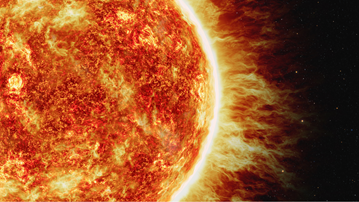What's the Weather in Space?
Forecasting in Space
December 28, 2023
by Eryn Dael, Education Coordinator, Imagination Station
Weather doesn't always seem to cooperate with our plans here on Earth. Often we’ll have rain and wind when we want to see a bright clear sky. Despite all of its fluctuations, the weather on Earth is pretty nice for its inhabitants. Especially if we compare it to the weather out in space.
Weather conditions on the Earth are kept relatively steady because of the Earth’s dense atmosphere that holds in heat. Earth also has a magnetic field that protects us from space weather.
An atmosphere is the envelope of gas that surrounds a planet or star. The sun's atmosphere is called the corona which means crown. The corona is usually very difficult to see because of the extreme brightness of the sun’s surface. Unlike the earth’s atmosphere, the Sun’s corona is very wild. For example, when viewing the sun there are often dark spots that form randomly on its surface. These are called sun spots. They are areas with a high magnetic presence. Eventually, they lead to explosions called solar flares which can be seen as strings of light that protrude from the sun's surface deep into space.

Every 11 years, the sun goes through a solar cycle in which it completely reverses the polarity of its magnetic fields. Around the time the field flips is when scientists observe the most solar activity with sunspots and solar flares. Just like the Earth, the Sun has a north and a south pole. Yet, unlike the Sun, the Earth’s magnetic field only reverses about every 300,000 years.
The frequent field reversal that we observe on the Sun causes a lot of magnetic explosions. These are called Coronal Mass Ejections (CME). They occur when the sun's magnetic field lines get twisted and then suddenly reorganize quickly. CMEs spew a large amount of radiation and particles from the Sun at speeds that are fast enough for the particles to escape the Sun's immense gravity. These charged particles can make it all the way to the Earth and other planets in our solar system. Activities such as CMEs and solar flares are the most intense explosions that occur in our solar system and they create what we call space weather.
Luckily, the Earth's magnetic field and atmosphere protect us from the charged particles by deflecting them to the poles. This leads to what we know as auroras — brilliant shows of light in the sky. Space weather is constantly happening, but while we often don't experience the effects of it, in strong cases, space weather can damage power grids and disrupt radio communication.
Predicting space weather is a field of heliophysics ("helio" refers to the Sun) where scientists observe sunspot activity and solar cycles to predict when intense solar activity will occur. These scientists are essentially space meteorologists!
Make sure you don’t miss your own opportunity to make coronal observations when the total solar eclipse happens on April 8th, 2024.
For today’s space weather forecast visit: https://www.swpc.noaa.gov/
To learn more about the space weather, the corona, sunspots, solar flares, and auroras visit NASA’s webpage:
https://spaceplace.nasa.gov/spaceweather/en/
Follow these links to learn more about the weather on all of the planets in the Solar System: https://spaceplace.nasa.gov/weather-on-other-planets/en/